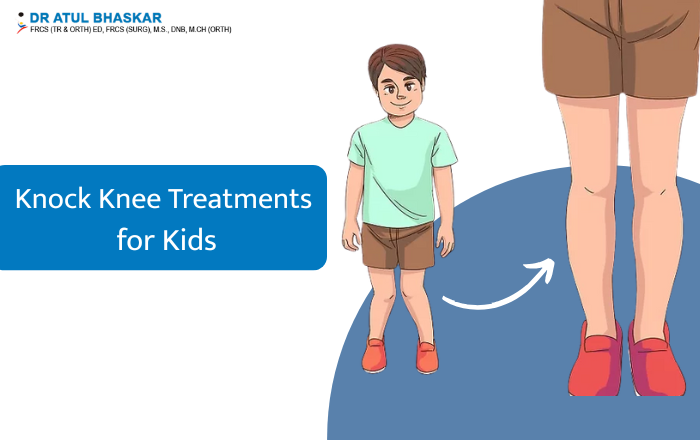As a parent, it’s natural to notice every detail about your child’s growth and movement. If you’ve seen your child’s knees turning inward while standing or walking, you’re not alone. This condition is commonly known as knock knees in children, and it often raises concerns among parents. The good news is that, in many cases, it’s just a part of normal development. But when should you be concerned? And what can be done if it doesn’t go away on its own? In this blog, we’ll walk you through what knock knees are, why they happen, and how they can be treated effectively.
What Are Knock Knees in Children?
Knock knees, also known as genu valgum, is a condition where a child’s knees touch or come close together while the ankles stay apart. It often becomes noticeable between the ages of 2 and 5 and usually corrects itself by age 7 or 8. During early growth, changes in leg alignment are common, and knock knees are a natural part of this phase for many kids.
In some cases, however, knock knees can be caused by other factors like:
- Genetics
- Poor nutrition, especially lack of vitamin D and calcium
- Being overweight
- Previous injury to the leg
- Certain bone diseases
If the condition doesn’t improve over time or seems severe, it’s worth looking into further.
Signs Parents Shouldn’t Ignore
While many children grow out of knock knees, some signs may suggest that it’s more than just a passing phase. Look out for:
- Constant knee or leg pain
- Difficulty walking or running
- Limping or awkward walking pattern
- Shoes wearing out unevenly
- One leg appearing different from the other
If any of these symptoms are present, it might be time to see a pediatric orthopedic surgeon.
Treatment Options for Knock Knees in Kids
1. Observation and Regular Check-ups
Most children with mild knock knees do not need treatment. Doctors may suggest simply monitoring the condition with regular check-ups until the child grows older.
2. Physical Therapy and Exercises
In cases where the alignment does not improve or if the child experiences discomfort, exercises for knock knees in children can help. These exercises aim to strengthen muscles around the hips and legs. A physical therapist may teach your child stretches and strength-building routines like:
- Side-leg raises
- Step-ups
- Hip abduction exercises
- Hamstring stretches
Practicing these regularly at home can support better alignment.
3. Bracing or Orthotics
Sometimes, shoe inserts (orthotics) or night-time braces may be recommended. These help in guiding leg growth, especially in younger children. This treatment is only used if the knock knees are more noticeable or continue to get worse.
4. Diet and Nutrition
Proper bone health starts with a good diet. Children need foods rich in calcium and vitamin D. If your child is underweight or overweight, helping them reach a healthy weight can also reduce pressure on the knees.
Foods to include:
- Milk and dairy products
- Green leafy vegetables
- Eggs
- Fish (like salmon)
- Sunlight exposure for natural vitamin D
This can support natural bone growth and may help correct knock knees naturally.
5. Surgery (in Rare Cases)
Surgery is only considered when knock knees are severe and continue after the age of 10, or if the condition causes pain or difficulty in walking. There are procedures like guided growth or bone straightening (osteotomy) which are done by trained pediatric orthopedic surgeons. This option is usually a last step when other methods have not worked.
How a Pediatric Orthopedic Specialist Can Help
A pediatric orthopedic surgeon can check your child’s leg alignment, assess how the bones are growing, and decide what steps are needed. This may include an X-ray or a walking analysis. Early guidance can help prevent problems later in life, such as knee pain, poor posture, or difficulty in movement.
When to Seek Medical Advice
Visit a doctor if:
- Your child’s knock knees are getting worse after age 7 or 8.
- There’s pain, limping, or an unusual walking pattern.
- One leg seems more affected than the other.
- The condition appeared suddenly, not gradually.
It’s always better to get a professional opinion if you’re unsure.
FAQ
Q1. Is knock knee normal in toddlers?
Yes, knock knees are common in toddlers between ages 2 to 5 and usually improve as the child grows.
Q2. What is the best treatment for knock knees in children?
Mild cases may need no treatment. Others may benefit from exercise, bracing, or rarely, surgery.
Q3. Can knock knees be corrected naturally?
Yes, in many children, regular exercise, proper nutrition, and physical activity help correct the condition.
Schedule a Consultation With Dr. Atul Bhaskar,
If you’re worried about your child’s walking or leg shape, don’t wait. Early support can make a big difference.
Dr. Atul Bhaskar, a trusted
Pediatric Orthopedic Surgeon in Mumbai, has years of experience helping children with conditions like knock knees. Book a consultation to understand your child’s needs and get the right guidance.
